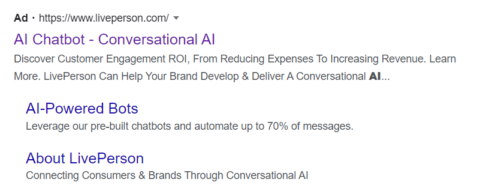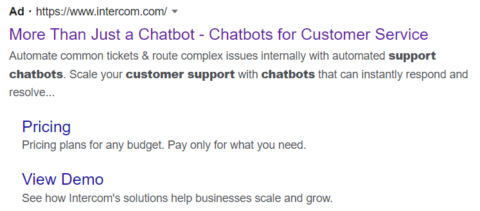In a world of multi-channel marketing for B2B, narrowing down a specific space where your leads are generated takes time.
Many B2B marketers turn to Google Ads because it has the potential for a quick return on investment (ROI).
But for that scenario to happen, you’ve got to have the right strategy and tactics in place.
Lucky for you, this article will take you from, “I don’t know where to focus my time & budget,” to “I’m managing my Google Ads budget & collecting B2B leads like a boss.”
In fact, Google Ads is among the top most effective paid channels because you can understand the level of “purchase intent” based on the type of keyword used.
So, when you target keywords across multiple intent stages within the sales funnel, creating B2B Google Ads campaigns enables you to efficiently nurture leads toward conversion.
With this in mind, mastering the art of B2B Google Ads campaigns can skyrocket your company’s growth and help you develop a bulletproof, long-term marketing strategy.
So, if you’ve been pondering the question:
“Do Google Ads work for B2B and how can I get the most bang for my buck?”
This article will answer this and set you up for sustainable future success.
Why Use Google Ads Campaigns For Your B2B Lead Generation Efforts
Many ask, “Why should I pay when I can generate leads for free?”
Great question.
First off, let’s start with the fact that no leads come for free. No matter whether you do SEO, social media marketing, or paid advertising, there’s no such thing as free lunch.
All marketing channels have their pros and cons, but Google Ads, in particular, are useful because they:
- Give you the power to control your growth pace based on ad spend and campaigns used.
- Are often quicker to launch because you can start with one landing page.
- Enable you to drive traffic to content based on “high purchase intent” keywords, i.e., search phrases that describe the product or service you’re selling.
In fact, the average B2B Google Ads campaign conversion rate is 3.75%, so if you target high purchase intent keywords, you’ll generate high-quality leads that have a strong chance of becoming customers.
Ready to jump on the Google Ads bandwagon successfully?
Let’s go over how to run a B2B Google Ads campaign based on purchase intent stages within the sales funnel.
How To Run Successful B2B Google Ads Campaigns Based On Sales Funnel Stages
A sales funnel typically consists of three main categories:
- The top of the funnel (TOFU): People who are in an awareness stage in their buying cycle, meaning they’re just becoming aware they have a problem and need to find a solution.
- The middle of the funnel (MOFU): People who are interested or considering buying, and are making comparisons and researching further about the best solution for their specific needs.
- The bottom of the funnel (BOFU): People who are nearly ready to make a purchase and have decided to initiate contact with companies who might be able to help them.
The idea is to craft your B2B Google Ads campaign based on each specific category, using keywords that relate to those corresponding categories.
By doing this, you’ll be able to craft better copy geared towards audiences at the “top of the funnel” compared to those at the “bottom of the funnel,” which will help your campaigns to convert better.
Now that you’ve got the idea, let’s dive into some concrete keyword and campaign examples per funnel stage.
Top Of Funnel
In the TOFU stage, some keywords that might be relevant here are:
- “what is x.”
- “x definition” – because they’re just trying to understand the basics of a certain concept.
Because your audience is ready to soak up all the information, informational long-form content is especially important for them.
Your audience might be aware your brand exists, but not aware of everything you have to offer. They’re a beginner when it comes to the solution you provide, so there shouldn’t be any pushy sales copy here.
Your audience is just warming up to you and they don’t want to be spammed.
When it comes to your bid strategy, you have two options:
- Option 1: Use ECPC (enhanced CPC), which is not entirely automated bidding, but it does allow you to have more control over your budget.
- Option 2: Targeting impression share works well if your objective is brand awareness and reach because you can set a percentage for your impression share against other bidders.
For your retargeting strategy, it’s a good idea to set up an audience on Google to collect visitor information to the page you send users.
Depending on the traffic amount (1,000 or more visitors are needed before you can retarget), we can use this audience for retargeting our MOFU campaign.
You also need to set the goal type.
Your first campaign should not be a hard sell, as here, you need to focus on generating demand for your product or service.
Naturally, there may be an influx of new users (but hardly any conversions), so you’ll want to ensure your campaign objective offers a high-value and low-friction micro conversion, such as getting someone to read an informational content piece.
Depending on the volume of users, you should look at setting up a micro-conversion for page engagement.
Below is an example of a TOFU B2B Google Ads campaign in action targeting the keyword “what is an ai chatbot.”
 Screenshot of search for [what is an ai chatbot], Google, December 2022
Screenshot of search for [what is an ai chatbot], Google, December 2022
The ad introduces the brand and answers the keyword in question. Clicking through to the landing page, we’re not introduced to a hard sell, but instead are given a “complimentary guide” to learn more about this specific AI Chatbot.
There is no mention of pricing, or the specific product here. It matches the user search intent by providing the user with exactly what they requested.
The bonus is it also allows the business to collect email addresses, which can then be sent email nurturing campaigns later on.
Middle Of Funnel
Your MOFU audience members are those who know your product or service exists and have done some research on potential solutions.
They might even already be considering you as an option, but need to know exactly how you can help, and why you’re a better choice than your competitors. Their decision is also likely heavily influenced by third-party opinions of your brand.
In this case, your Google Ads campaign could promote the following:
- Technical “how-to guides.”
- Product comparison.
Your audience likely has a foundational understanding of the topic or industry, but they’re still looking to improve their knowledge and identify the best solution for them.
Cue offer messaging here! Your people are getting ready for an information-based soft sell.
For your bid strategy, it would be a good idea to use the following:
Unlike ECPC, Maximize Clicks is an automated bidding strategy where Google sets the bids for you, to get the most conversions for your campaign while spending your daily budget.
Once you’re ready to retarget, here’s a possible approach:
Take a look at your previous audience setup for users clicking through from your TOFU campaign and your general website visitors. It’s worthwhile to add this audience as an observation on this campaign.
 Screenshot by author, December 2022
Screenshot by author, December 2022
You can increase bids for users who have already interacted with your brand, which ensures your ads are in a higher position and keeps brand awareness at the forefront.
Again, using audiences from this page and adding bid targeting to your BOFU campaign is a good idea.
For your MOFU goal type, you’ll need to offer more information to help your audience decide – but at this stage, you’ll want to get into the nitty-gritty details.
Although users might be somewhat unaware of your brand, they have a good sense of the product or service they want, as they are now fully in their research phase to find the most suitable product or service to fulfill their needs.
The goal here can be offering downloadable guides and product comparisons while also still using micro-conversions, such as tracking a conversion for every download.
To give you a better idea, let’s take a quick look at a MOFU B2B Google Ads campaign example targeting the keyword “how to set up an ai chatbot.”
 Screenshot of search for [how to build a chatbot], Google, December 2022
Screenshot of search for [how to build a chatbot], Google, December 2022
With this ad example, the user has likely done enough research to start looking at ways to install a chatbot, which the ad answers exactly that question with the ad copy.
Furthermore, we can see that, similar to TOFU, there isn’t a hard sell on this page, as the user intent isn’t yet to purchase their product. Instead, they have offered a free ebook in exchange for contact details.
Bottom Of Funnel
BOFU is where the magic happens: lead generation conversions. Your audience is ready to buy and needs one more push to click that purchase, book a demo, or contact us button.
Relevant keywords here might be:
- x service.
- x tool.
- x platform.
At this stage, you’ll want to whip out your conversion-based landing pages and ask for the sale because:
- Your audience here is strongly aware of your brand.
- They’re considering making a purchase and have a decent understanding of your solution.
For your bid strategy, consider using Maximize Conversions, as users are nearly at the end of their decision-making and are more inclined to get in touch with you.
When you’re ready to retarget, enable retargeting for all users who visit this page but don’t convert. You can also retarget users using display campaigns on Google or other similar platforms, such as AdRoll.
It would be worth considering setting up retargeting on other platforms, such as LinkedIn and Facebook, too.
Because this campaign has the highest intent for the users in the purchase cycle, a high-converting landing page is recommended here that offers all of the above information and more.
This is your chance to offer lead forms and get in touch with forms that include calls to action (CTAs) at the top and at easily accessible points throughout the page.
To give an example, check out this Bofu B2B Google Ads campaign for the keyword “ai chatbot for customer service.”
 Screenshot of search for [ai chatbot for customer service], Google, December 2022
Screenshot of search for [ai chatbot for customer service], Google, December 2022
From the above BOFU keyword, we can now be sure the user knows exactly what they need – it’s now just picking the perfect solution for them.
By understanding the specific use case, the ads have been tailored for each scenario, increasing CTR. It also lists relevant site link assets (AKA extensions) that the user will also find useful, such as pricing and demo.
Secondly, the landing page used here is a high conversion page in that it offers relevant CTA’s throughout the page, uses trust-building messages, contact CTAs, and, more importantly, it highlights the product’s value.
Implement The Right Google Ads Strategy To Generate High-Quality B2B Leads
Overall, Google Ads is incredibly effective for B2B businesses because it’s a great starting point for long-term growth.
Not only can you retarget across other channels, but you also have the ability to target keywords based on level purchase intent within the sales funnel.
Now that you’re a pro at B2B Google Ads campaigns, you’ll be able to spend smart and optimize effectively!
More research:
Featured Image: VectorMine/Shutterstock
